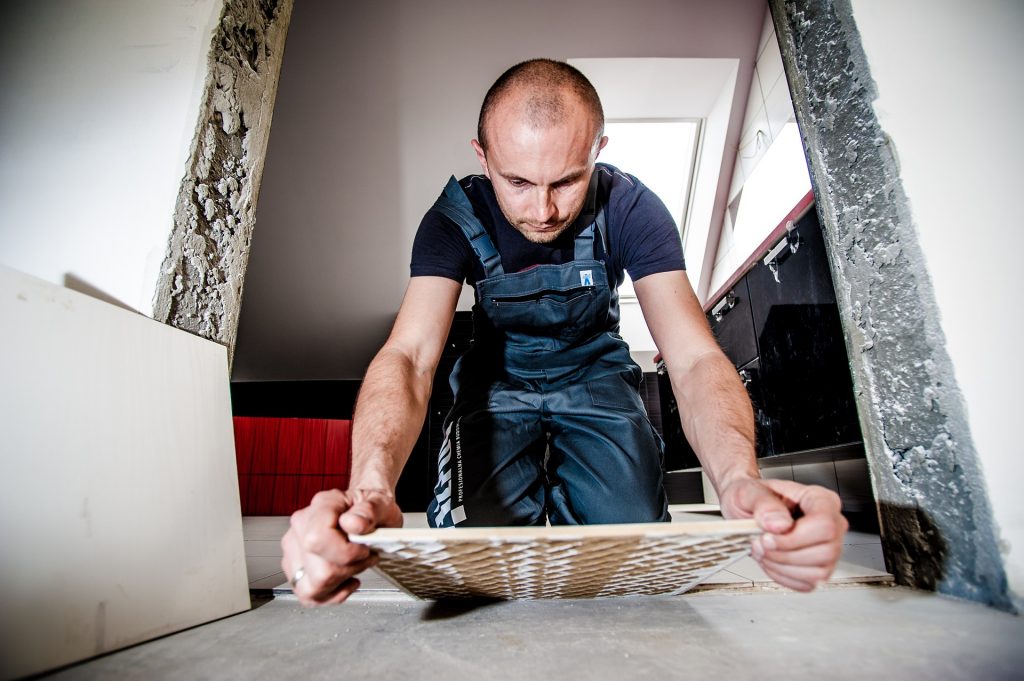In this article, you will find a list of 4 things you must not do during the underfloor heating system installation and the four things you should do instead.
Mistake Nº 1: Improper Installation of Tiles

Since hydronic radiant heating utilizes PEX tubing to move hot water beneath your floor, it is crucial that the tiles in your home are properly installed first. If they are not installed over a flat surface or if not enough tile adhesive or scree is used during installation, the tiles will crack when pressure is applied. Additionally, with the tubing being 3/8” thick, its installation can only be done two ways: it can either be installed along the subfloor or be installed in an even layer of concrete.
Here’s What You Can Do Instead:
Ensure that enough adhesive is used and that the surface on which the system will be installed is flat. This can be done by letting the concrete dry for at least 24 hours before beginning the installation of a new tile. You can also choose to install electric radiant heating as it uses thin pads with electrical wire. With the pads being so thin, you can simply unroll them directly beneath the tile. You’ll just have to make sure that you use a liberal amount of tile adhesive to ensure there are not any points of pressure on the bottom of the tile. You can also invest in thicker, higher quality tile as high-quality tiles can withstand greater force without cracking.
Mistake Nº 2: Not Knowing that You Will Have to Accommodate for the Added Floor Height

This is a rather common mistake since heating systems do not add much in terms of floor height. If you choose to have an electrical underfloor heating system installed, you won’t even have to worry about this factor as the additional floor height for this type of system is generally minimal. If you choose to get a PEX hydronic system, on the other hand, you will have an additional floor height of at least one inch. However, you should only worry about this if you are installing the heating system in a single room. You won’t face this problem if you are installing the system in a new home or if you are redoing an entire floor of a house.
Here’s What You Can Do Instead:
If you are indeed installing a new underfloor heating system in one room, remember to take into account the fact that there will be a slight step leading to areas that do not have underfloor heating. And if you think it will be impossible to add a step in your home, it would be a better idea to go the electric underfloor heating route. Just avoid an electric underfloor heating system for large areas in your home. See Mistake #5 for more details.
Mistake Nº 3: Not Evenly Spacing the Underfloor Heating System During Installation
Essentially, you want to avoid spreading the heating mechanism out over a large area in the house. Usually, this mistake can occur in two ways: calculation for heat loss in your home is not calculated properly, or there is too much piping. If the heat loss of your home is not accurately measured before installing an underfloor heating system, you will end up with an unevenly spaced system under the entire floor. There is also the risk of installing way more pipes than needed, which will also in an overheated room and a higher installation cost.
Here’s What You Can Do Instead:
Ensure that the heat loss calculation is done and is done properly. This can be done by using the below rule-of-thumb approach for calculating heat loss:
- Chronic boiler oversizing
- Micro loads and short cycling
- Temperature ‘parasites’
- Improper radiant installation
Then, ensure that the team you contracted is evenly spacing the underfloor heating systems throughout the entire room. Finally, ask whether the system is powerful enough to heat the space between each wire in an electrical system or each PEX pipe in a hydronic system.
Mistake Nº 4: Not Relying on Other Heating Sources Other than An Electric Source

While radiant floor heating is an excellent way of maintaining overall home temperature, they can cost a lot in terms of electricity bills. The biggest mistake you could make is choosing to rely on an electric source only: The monthly electricity bills will rise even more steeply if you have underfloor heating for large areas in your home.
Here’s What You Can Do Instead:
To make underfloor heating an efficient form of heating, it would be better to rely on an alternative method, such as using a hydronic system as your main heating system. This is an excellent solution if the hydronic system is installed in a concrete slab that will hold the heat over time.





